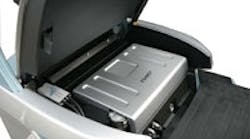While the continuing transition to electric battery-powered lift trucks may suggest only environmental concern, the trend is really part of a broader search for new levels of performance and productivity.
The shift to electric continues to be the biggest and most evident trend in the industry, says Martin Boyd, national product planning and marketing manager at Toyota Material Handling USA Inc. (TMHU). "If you look back 12 or 15 years, the split between electric lift trucks and internal combustion models was about 60% to 40% in favor of internal combustion. Since then that trend has flipped in favor of electric," he says.
A contributing factor is the growing emergence of technology to transition lift trucks to become better and stronger competitive differentiators, says Jim Malvaso, president and CEO, Raymond Corp. "Lift trucks aren't a utility that is there just in case of a need to move a pallet. They are integrated into the customer's system for a dedicated, competitive payoff."
According to Boyd, "Much of the current progress in electric lift trucks can be attributed to the shift to AC technology." The result, he says, is the closing of the performance gap between electric and internal combustion-powered models.
"AC systems encouraged a lot of customers to rethink their ideas on using battery-powered technology," says Boyd. "Not only did they gain enhanced battery-powered performance, but that improvement was obtained without producing emissions such as carbon monoxide. In addition, the battery-powered lift trucks make little noise and are typically small enough to permit operation in narrow aisles."
To further facilitate the use of battery-powered lift trucks, TMHU has teamed with the provider of PosiCharge fast charging systems, AeroVironment Inc. Its systems are designed to maximize operator uptime and throughput by eliminating the need for complicated charge schedules. "PosiCharge," says Boyd, "ends the need for battery changing rooms and manual battery handling. That minimizes the danger of lead acid spillage and other environmental and safety hazards." He says the extended lifecycle of batteries combined with a company's reduced battery inventory also means that fewer batteries are heading to landfills. With the fast charging concept, only one battery per truck is required. Boyd says fast charge batteries are charged throughout the day -- whenever the truck is idle.
Meanwhile Toyota maintains a commitment to the clean and green internal combustion (IC) lift trucks. For example, its 8-Series IC lift truck, powered by liquefied petroleum gas, compressed natural gas or gasoline, produces 70% less smog forming emissions than allowed by federal regulations, says Boyd.
See Also



